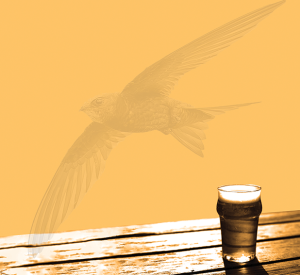Participating in a social Swift survey, Horatio Morpurgo ponders conversation, counts, and questions that hang in the air.

THE SWIFT PINT was introduced and explained at a meeting in Bridport Town Hall. Those wishing to be involved would take up position on a summer’s evening outside a number of evenly spaced pubs. Over the same half hour, at precisely timed five-minute intervals, everybody would look up and count how many swifts they could see. Someone from each group would record and then send numbers to the survey’s coordinator, ecologist Tom Brereton, to collate the data. Three Swift Pint Surveys for 2025 were advertised well in advance. Bridport has enough cavity-riddled old buildings that its population of this charismatic creature is still quite high. The aim was to gauge its status more exactly.
Some backstory: 180 years separated Gilbert White’s observations of this ‘amusive bird’ and publication of Swifts in a Tower (1956) by David Lack, the first properly scientific study. Less than 12 months separated two recent titles on the same subject – Mark Cocker’s One Midsummer’s Day: Swifts and the Story of Life on Earth (2024) and Hannah Bourne-Taylor’s Nature Needs You: The Fight to Save Our Swifts (2025). Behind the Swift Pint is a wider surge of interest and concern.
Brian and Sue are old friends and have birdwatched all over Europe. The Crown Inn, which they were assigned, stands by a roundabout where the A35 by-passes the town. Birding’s way of leading you to unlikely locations is part of its charm. But a peregrine falcon sailed over as we occupied an outdoor table and set the tone. Between our scannings of the sky, conversation ranged far and wide. Sue curates the Roman collection at the town’s museum. A retired civil servant, Brian has a knowledge of planning law which makes him the indispensable member on any environmental committee.
Larger numbers of swifts were counted over the middle of town. We mainly saw ones and twos. But the Crown’s landlord was enthusiastic anyway. Plus part of the point of the Pint is the conversation it occasions. We’ll come back to this.
A swift brick looks like a normal one but has a small opening which leads to an internal cavity space. It is essentially a nesting-box fitted flush to the wall. Hannah Bourne-Taylor’s Nature Needs You tells the story of her campaign to make their installation mandatory with all new-build. Launching a petition, she set about collecting the 100,000 signatures needed to trigger a parliamentary debate. She wore nearly nothing to deliver her ‘Feather Speech’ in Hyde Park, then did the same in a TV studio where she fielded questions about tits from Piers Morgan. She watched the campaign to ban fishing for sand-eels in UK waters win and took heart.
Bourne-Taylor had returned to England in 2021 after eight years living in rural West Africa. This sheds some light perhaps on her claim to have ‘never before’ connected biodiversity loss with politics. The XR moment passed her by. What might have undermined her case, though, instead strengthens it. As she wakes from this ‘sleep-walking’, her instincts are C/conservative – she joins a local swift group, sits on the parish council, believes in the parliament she is seeking to influence. Believes in the free speech exercised at Speaker’s Corner. Uncomfortable with direct action, she goes out of her way to be the kind of loyal, active citizen our democracy claims to want. And it is true that governments will occasionally throw a sand eel to environmentalists who behave. She is right to feel this is worth doing.
So she does the buzz, clocks up her 100,000, secures her debate. And for all it achieves, might as well have blocked the M25. Neither a Conservative nor a Labour government is able or willing to legislate for the measure in any form. Swift bricks cost £25 each. The four biggest housebuilders made profits in 2024 of £2.7bn. That said, the craven nature of political establishments will not come as a surprise to some readers. The term ‘capitalism’ has its uses and to my mind she is far too polite in her avoidance of it.
But there is another way to read Nature Needs You. Just before she delivers her Feather Speech, sitting in an artist’s studio being covered in body-paint, she calls the Press Association to tell them what she is about to do. The guy who picks up is loving this no-clothes angle. Less predictably, he likes swifts, too – ‘always in a Bob Murray’, as he puts it – rhyming slang for ‘hurry’. His Dad, it turns out, used to take him birdwatching and it wasn’t all lost on him.
The other way to read this is as a book about hurry. The hurry swifts are in – last to arrive, first to leave – as a metaphor for the hurry its author is in and indeed the hurry we are all in – and the media as that human hurry’s chief manifestation. Bourne-Taylor is at her best exploring the close relationship between all the hurry, all that ‘traction on social media’, and our abundance of not getting anywhere.
For three months the miniature falcons float so sky-high above our lives that we are scarcely conscious of that faint shrilling – till suddenly one of them whirs by screaming in your ear like your kid on a fun-ride. It’s the play of contraries that I love about them, the way they tilt at life this way and that, try one angle, try another. And whether they are going at it high or low, that flickering capacity to switch any second, from planing to plunging or soaring.
Perhaps such a view of them is peculiar to middle age – or certainly they make their appeal to anyone who never seems to have enough time. The Swift Pint Survey, for example, was only one element in a whole programme of swift-related events around town – guided walks, a dance show, story-telling. And I live in such a perpetual Bob Murray that I somehow contrive to miss everything apart from these gatherings next to a roundabout on the A35.
Returning in mid-June for the second survey, my daughter tags along. Between school and university, swifts are topical: they have just flashed across her postcolonial reading-list ‘with a humming-bird’s electric wings, this engine / that shot ahead of each question like an answer’ (Derek Walcott’s Omeros). Her godfather, another birdwatcher, also shows. He restores old buildings and has photos of the swift brick he has just installed. My own goddaughter, still in the midst of A-levels, takes a break from revision to be there too. She praises a difficult but strangely beautiful question from a Physics paper, about the sun’s structure. Part of the point of the Pint is once again the conversation it occasions.
Mark Cocker’s One Midsummer’s Day happens in his garden in Derbyshire but roams if anything even further afield than those ‘flying dots quaking in the ether’ above him. It is to his credit that he frets at the limits of ‘nature writing’. So his book planes and plunges, for example, into the process whereby hydrogen is turned to helium at the sun’s core. It tracks the resulting energy as it streams across the solar system. He makes this process the centrepiece of his case for imaginative engagement with science, as opposed to Lawrentian impatience with it. Although that match surely ended in a one-all draw some time ago.
If Bourne-Taylor lives too much from headline to headline, Cocker walks to a slower beat, inscribing himself in a long tradition of English nature writers. Neither writer mentions the other and Cocker is most original where he is furthest from Bourne-Taylor’s approach. To study the swift with him is to hear in their shrilling ‘the story of life on earth’, to hear geological time percolating into the minds and everyday lives of towns and villages.
So the seasonal changes which bring them to us each year are traced to a planetary collision over four billion years ago, from the aftermath of which our moon was formed. Its gravitational pull keeps the earth’s tilt within bounds, allowing for a seasonal variation hospitable to life, rather than the excessive heat and cold of Mars, say, which has no such neighbouring mass to ‘anchor’ it. He traces the emergence of our breathable atmosphere, our plants and insects – of everything, in short, without which the ‘near-perpetual mobility’ of this bird (and ourselves marvelling at it) could never have come to pass.
The question of what gets through to people is surely by now the one that counts. For all their differences, both books are genuine attempts to answer it. They naturally prompt reflection on what it was that got through to you. One weekend evening in the mid-Seventies, the teacher on duty at a Hampshire boarding school led a party of full-time boarders up an Iron Age hillfort. From its ramparts, he pointed out swifts far above us and explained how they climb into the sky every night and sleep up there on the wing. There seemed to me then a touch of science fiction about a creature which spirals upwards at dusk until it has disappeared from the face of the earth, only to rematerialize the following day.
This impression was confirmed a year or two later when I read in a wildlife magazine about a swift found dying which had been ringed sixteen years earlier, as an adult, making it at least eighteen years old. It was calculated to have flown in its lifetime the equivalent of nearly four times to the moon and back. One of these dark stars then fell to earth in the village where I spent my holidays. It sat patiently against a backdrop of our garden while I took the photographs I still have. Having accepted a drop of sugar solution, I tossed it into the air, from which unceremonious launch it rocketed away directly south.
Some or all of these were what got through to me. Which is easy enough to say. What it leaves out of the account is that anticipation any ten-year-old has of everything he has yet to learn. A young swift heads directly south from the nest-site, unaccompanied, because a receptor in its right eye can see the earth’s magnetic field. They know the way to Central Africa from anywhere. A child’s eye is perhaps equipped with some such receptor. It, too, can tell the direction in which what he wants to know will be found, before he has any clear idea what it is.
But it isn’t only our own formative experience we look to. Swifts nest each year under the eaves of an old chapel across the road from my son’s primary school. Through every summer term for the last four years their screaming and circling has gone on a few feet above that milling of parents, children and vehicles at drop-off time. Earlier on the day of the third and final Swift Pint, in mid-late July, my son and I had passed beneath that ‘circusing’ of swifts, walking together to his last day at primary school.
He was tired now but agreed to cycle down to the Crown Roundabout. My wife joined us, too. A trainee psychotherapist, she has looked into how environmental concern is now affecting practise, from women who choose not to have children to outdoor therapy sessions. Part of the point of the Pint.
We shared the pub garden this time with the first tourists of the season, a family from Wales, whose children joined in the survey. Standing next to a roundabout on the A35, I channelled that long ago teacher on an Iron Age hillfort. I pushed that old mind-expanding statistic of mine and all that sleeping-on-the-wing stuff, in hopes that my captive audience might get as high on them as I did once.
For Hannah Arendt ‘natality’ was the ‘central category’ of political thought. Natality she defined as ‘the new beginning inherent in birth’ which makes itself felt in the world ‘only because the newcomer possesses the capacity of making something anew, that is, of acting.’
Both of the books I’ve described are actually branches off a common trunk. Swifts in a Tower (1956) documents the decade which David Lack spent studying a colony of swifts in the tower of Oxford’s Natural History Museum. It begins with the laying of that museum’s foundation stone in 1855. It was profit from OUP Bibles which made the building possible. The confrontation between Thomas Huxley and Bishop Wilberforce, Lack reminds us, would occur only five years later and inside the very building then under construction. But in 1855 the Darwin debate was both very near and foreseen by almost nobody.
On that long-ago June day, ‘a group of bearded and reverend scientists, a combination now, alas, unknown, joined to sing the Benedicite in the open air at the edge of Oxford,’ Lack wrote. ‘In those days, scientists knew that God was glorified in His works…’ What did he mean by this? He had written a book on the Galapagos finches and it was as an instance of extreme adaptation that swifts, too, interested him. The flight pattern I enjoy so much is explained as an adaptation to their diet of aerial insects. Chicks can endure parental absences that no songbird’s young ever could, entering a torpid state in which they use almost no energy. This is an adaptation to fluctuations in insect-numbers available this far north.
But the book’s opening chord returns at the end as he draws its surprising conclusion. Natural selection best explains the behaviour and form of the swift. But it operates in response to variable circumstances, to the fluctuating abundance of insects, say. The drama of near-starvation played out under the eaves of Oxfordshire villages each summer might astonish and even shock their human inhabitants. But taken to its logical conclusion, Darwin’s discovery also calls into question the origin of human values. For if the idea of the good or the true evolved, like a swift’s nesting habits or wing-structure, as a response to circumstances which vary, why should we trust those ideas of the good or the true?
To have more than an arbitrary, provisional meaning, Lack argued that values must be related to something ‘outside men and nature’. If our ‘beliefs and actions’ are ‘wholly determined’ by evolution, then free will is ‘an illusion and truth and goodness of no ultimate significance,’ a conclusion which seems ‘in theory to be self-destructive and in practise to lead to evil acts.’ He was surely speaking from the direct experience of his generation.
He acknowledges that ‘this is a grave matter with which to end a bird-book’, but this is his conclusion nonetheless. Those men of God who caused the museum’s tower to be built ‘held that the study of nature should lead us, through a truer understanding, to a fuller worship of the Creator, and the times urgently require us to search out the basis of our lives.’ Lack sought that basis through studying the common swift. To judge by these two more recent books, we are searching for it there still. Even as their numbers dwindle and the gap widens between what needs to be done and the political readiness to effect change.
Just a week after the third and final Swift Pint was poured, they were gone. I had never before felt so strongly the abruptness of that departure. They left a question hanging in the air, as we loaded the car for departures of our own or arranged play dates upon our return. We may quibble with Lack’s bearded and reverend scientists but we surely remain in more need than ever of some shared, over-arching principle which can get through, which can inform decisions and then hold us to them.
At the core of any education that matters, Goethe once argued, is a three-fold reverence. Reverence for what is above, for everything that is of the heavens, reverence for the earth which sustains, and reverence for other people and everything that is to be learnt from them. ‘Only when combined to form a whole,’ he wrote, do these three ‘attain to their highest power and effect.’




